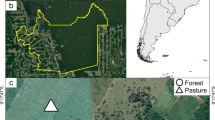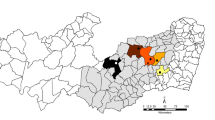Abstract
The Nimba Mountain Range located in the West African countries of Guinea, Cote d’Ivoire, and Liberia is part of the Upper Guinean Forest ecosystem, a critical biodiversity hotspot highly threatened by human activities. Dung beetle sampling on the Mount Nimba Strict Nature Preserve and in the nearby Bossou Forest or Hills Reserve in Guinea was done to document the dung beetle species diversity of the area in both different habitats and elevations ranging from about 600 to 1600 m and to assess, via this surrogate fauna, the biotic integrity of this World Heritage Site. As expected, evidence revealed a trend of lower diversity and abundances at the highest elevations but sometimes high variability even between similar habitats and at similar elevations. While a total of 50 species and 955 individuals were collected from all sites, the highest diversity and abundances were found in a high elevation forested savanna at ~1200 m where a total of 24 species and 402 individuals were collected. At the highest elevation sampled at ~1600 m, a total of only eight species and 20 individuals were collected and all of these taxa were also found at lower elevations. Forests sampled at moderate elevations had similar faunas in some but not in all cases and always a unique pattern of species abundances. A high elevation savannah had the highest species diversity and abundance and may still have a relatively intact dung beetle fauna. Comparatively lower diversity and abundances than what was expected at some sites may reflect a declining ecosystem due to low mammal populations brought on either by small habitat size in Bossou or bush meat hunting in the Nimba Range. Preservation of this truly unique West African ecosystem will require continued protection from or careful regulation of human activities.




Similar content being viewed by others
References
BirdLife I (2021) Important Bird Areas factsheet: Mount Nimba Strict Nature Reserve. http://datazone.birdlife.org/site/factsheet/mount-nimba-strict-nature-reserve-iba-c%C3%B4te-divoire. Accessed 17 Apr 2021
Bryson-Morrison N, Tzanopoulos J, Matsuzawa T, Humle T (2017) Activity and habitat use of chimpanzees (Pan troglodytes verus) in the anthropogenic landscape of Bossou, Guinea, West Africa. Int J Primatol 38:282–302
Cambefort Y (1982) Les coléoptères Scarabaeidae s. str. De Lamto (Côte d’Ivoire): structure des peuplements et rôle dans l’écosystème. Ann Soc Entomol Fr 18:433–459
Cambefort Y (1991) Tropical savannas. In: Hanski I, Cambefort Y (eds) Dung beetle ecology. Princeton University Press, Princeton, New Jersey, pp 156–178
Cambefort Y, Bordat P (2003) Coléoptères Scarabaeidae s. str., Aphodiidae et Ceratocanthidae du mont Nimba et des régions limitrophes. Mémoir Mus natl hist 190:551–580
Cambefort Y, Walter P (1991) African tropical forests. In: Hanski I, Cambefort Y (eds) Dung beetle ecology. Princeton University Press, Princeton, New Jersey, pp 198–210
Colwell RK (2013) EstimateS: statistical estimation of species richness and shared species from samples.Version9. http://viceroy.colorado.edu/estimates/
Conservation International (2021a) Explore the Biodiversity Hotspots. Critical ecosystem partnership fund. https://www.cepf.net/our-work/biodiversity-hotspots. Accessed 17 Apr 2021
Conservation International (2021b) Guinean Forests of West Africa. Critical ecosystem partnership fund. https://www.cepf.net/our-work/biodiversity-hotspots/guinean-forests-west-africa. Accessed 17 Apr 2021
Cotillon SE, Tappan GG (2016) Landscapes of West Africa: A window on a changing world. https://eros.usgs.gov/westafrica/case-study/forest-ecosystem-east-nimba-nature-reserve-threatened-human-impacts. Accessed 17 Apr 2021
Curry-Lindahl K (1966) Zoological aspects on the conservation of vegetation in tropical Africa. Acta Phytogeogr Suec 54:25–32
d’Orbigny H (1913) Synopsis des Onthophagides d’Afrique. Ann Soc Entomol Fr 132:1–795
Davis ALV (1994) Associations of Afrotropical Coleoptera (Scarabaeidae, Aphodiidae, Staphylinidae, Hydrophilidae, Histeridae) with dung and decaying matter: implications for selection of fly-control agents for Australia. J Nat Hist 28:383–399
Davis ALV (1996) Habitat associations in a south african, summer rainfall, dung beetle community (Coleoptera: Scarabaeidae, Aphodiidae, Staphylinidae, Histeridae, Hydrophilidae). Pedobiolog 40:260–280
Davis ALV, Philips TK (2005) Effect of deforestation on a southwest Ghana dung beetle assemblage (Coleoptera: Scarabaeidae) at the periphery of Ankasa conservation area. Environ Entomol 34:1081–1088
Davis ALV, Philips TK (2009) Regional fragmentation of rain forest in West Africa and its effect on local dung beetle assemblage structure. Biotropica 41:215–220
Fauna and Flora International (2009) Cross-sectoral partnerships for conservation, sustainable management and improved livelihoods at the Nimba Biosphere Reserve, Republic of Guinea. https://www.yumpu.com/en/document/read/17607832/cross-sectoral-partnerships-for-conservation-sustainable. Accessed 17 Apr 2021
Gebert F, Steffan-Dewenter I, Moretto P, Peters MK (2020) Climate rather than dung resources predict dung beetle abundance and diversity along elevational and land use gradients on Mt. Kilimanjaro J Biogeogr 47:371–381. https://doi.org/10.1111/jbi.13710
Halffter G, Favila ME (1993) The Scarabaeinae (Insecta: Coleoptera) an animal group for analysing, inventorying and monitoring biodiversity in tropical rainforest and modified landscapes. Biol Int 27
International Union for Conservation of Nature and UN Environment World Conservation Monitoring Centre (2017) http://world-heritage-datasheets.unep-wcmc.org/datasheet/output/site/mount-nimba-strict-nature-reserve/. Accessed 20 Jan 2022
Kunz BK, Krell FT (2011) Habitat differences in dung beetle assemblages in an African savanna-forest ecotone: implications for secondary seed dispersal. Integr Zool 6:81–96. https://doi.org/10.1111/j.1749-4877.2011.00240.x. PMID: 21645274
Lebbie AR (2001) Western Africa: Coastal areas of Guinea, Côte d’Ivoire, Liberia, and Sierra Leone. World Wildlife Fund. https://www.worldwildlife.org/ecoregions/at0130. Accessed 17 Apr 2021
Magurran AE (2004) Measuring Biological Diversity. Blackwell Publishing, Oxford
McCain CM, Grytnes JA (2010) Elevational gradients in Species Richness. Encyclopedia of Life Sciences (ELS). John Wiley & Sons, Ltd, Chichester. https://doi.org/10.1002/9780470015902.a002254
McGeoch MA, Van Rensburg BJ, Botes A (2002) The verification and application of bioindicators: a case study of dung beetles in a savanna ecosystem. J Appl Ecol 39:661–672
Mittermeier RA, Robles-Gil P, Hoffmann M, Pilgrim JD, Brooks TB, Mittermeier CG, Lamoreux JL, Fonseca GAB (2004) Hotspots revisited. Earth’s Biologically Richest and Most Endangered Ecoregions. CEMEX
Monadjem A, Richards L, Denys C (2016) An african bat hotspot: the exceptional importance of Mount Nimba for bat diversity. Acta Chiropterol 18:359–375
Monadjem A, Decher J, Crawley WY, McCleery RA (2019) The conservation status of a poorly known range-restricted mammal, the Nimba otter-shrew Micropotamogale lamottei. Mamm 83:1–10
Mongyeh ET, Philips TK, Kimbi HK, Fokam EB (2018) Elevational and possible bushmeat exploitation effects on dung beetle (Scarabaeidae: Scarabaeinae) communities on Mount Cameroon, West Central Africa. Environ Entomol 47:1072–1082
Moretto P (2010) Les Scarabéides coprophages de bayanga en République Centrafricaine. Bull Soc Entomol Fr 115:455–477
Moretto P, Cosson B, Takano H, Basquin P, Bordat P, Boucher S, Bouyer T, Danflous S, Dérozier V, Eitschberger U, Juhel P, Leroy É, Limbourg P, Massa B, Meunier J-T, Miles W, Orbach E, Robiche G, Rojkoff S, Silvestre G (2021) Un refuge forestier menacé: La forêt d`altitude à Parinari du Mont Tonkoui en Côte d`Ivoire. Évaluation de la biodiversité entomologique, botanique et ornithologique. Valeurs de conservation du site. Cathar Rev Hors-Sér 1:1–123
Myers N, Mittermeier RA, Mittermeier CG, Da Fonseca GA, Kent J (2000) Biodiversity hotspots for conservation priorities. Nat 403:853–858
Poilecot P, Loua N-S (2009) Les feux dans les savanes des monts Nimba, Guinée. Bois Forets Trop 301:51–66
Samani D, Bosak K, Halvorson SJ (2023) Community-centered sustainable Ecotourism Planning in the Bossou Forest Reserve, Guinea, West Africa. Sustainability 15:4615–4639. https://doi.org/10.3390/su15054615
Sandberger-Loua L, Müller H, Rödel MO (2017) A review of the reproductive biology of the only known matrotrophic viviparous anuran, the west African Nimba toad, Nimbaphrynoides occidentalis. Zoosyst Evol 93:105
Sanders NJ, Rahbek C (2012) The patterns and causes of elevational diversity gradients. Ecography 35:1
Schäfer M, Demare G, Doumbia J, Rödel M-O (2022) Surviving the inferno: Nimba Toads, Nimbaphrynoides occidentalis (Anura: Bufonidae), hide from early dry season fire under rock shelters. Herp Notes 15:297–301
Spector S (2006) Scarabaeine dung beetles (Coleoptera: Scarabaeidae: Scarabaeinae): an invertebrate focal taxon for biodiversity research and conservation. Coleopts Bull 60:71–83
Sukhdeo CA, Philips TK, Tasse GC, Fokam EB, Morgan K (2019) Elevational variation of dung beetle (Coleoptera: Scarabaeidae: Scarabaeinae) communities on Bioko Island, Equatorial Guinea. Afr Zool 54:151–160
UNEP-WCMC Mount Nimba Strict Nature Reserve, Guinea and Côte d’Ivoire. The Encyclopedia of Earth. https://editors.eol.org/eoearth/wiki/Mount_Nimba_Strict_Nature_Reserve,_Guinea_and_C%C3%B4te_d%27Ivoire. Accessed 17 Apr 2021
Acknowledgements
We sincerely appreciate the support and permits given by the Institut de Recherche Environmental de Bossou, Direction Nationale de la Recherche Scientifique et Technique (IREB/DNRST), Republic de Guinee and the Direction Nationale de la Recherche en Primatologie de l’Université de Kyoto (KUPRI), Japan and especially Tetsuro Matsuzawa, who helped facilitate our research and accommodation at the institution in Bossou. Tatyana Humle helped us in making initial contacts and gave a lot of helpful advice on field work in the area. Iba Conde, Gbian Pierre Guemy, and Sakho Djemory assisted us during our stay in Bossou and Kassié Dore helped in the field in the Seringbara area. We also appreciate the generous in-kind assistance from the Société des Mines de Fer de Guinée (SMFG) and the many individuals there during our stay at the mine, including Phil Davies, Jamison Suter, and C. Halpin. Field work done by TKP was completed with William Lanier in 2010 and 2011 and with Alan Mudge in 2011 and the companionship and assistance of both is greatly appreciated. Scientific permits from the Ministere de L’enseignment Superieur et de la Rechercher Scientifique, Conakry, Republic de Guinee, are gratefully acknowledged. Our appreciation to Albert Meier and Cheryl Kirby-Stokes who read and edited early versions of this manuscript which was presented as an honors thesis for the second author. The comments from Frank Krell and one anonymous reviewer are greatly appreciated. We gratefully acknowledge the support of the Center for Biodiversity Surveys at WKU, the WKU Office of Sponsored Programs through the Research & Creative Activities Program, and an NSF Biological Surveys and Inventories grant (DEB 0430132) that helped support the two expeditions to the Nimba Range region in Guinea as well as research in Liberia.
Funding
Partial financial support was received from the Western Kentucky University Honors College and the National Science Foundation (DEB-04301320). The authors have no relevant financial or non-financial interests to disclose.
Author information
Authors and Affiliations
Corresponding authors
Ethics declarations
Ethics approval
This study did not require ethical approval.
Financial interests and non-financial interests
The authors have no relevant financial or non-financial interests to disclose.
Additional information
Publisher’s Note
Springer Nature remains neutral with regard to jurisdictional claims in published maps and institutional affiliations.
Supplementary Information
Below is the link to the electronic supplementary material.
Rights and permissions
Springer Nature or its licensor (e.g. a society or other partner) holds exclusive rights to this article under a publishing agreement with the author(s) or other rightsholder(s); author self-archiving of the accepted manuscript version of this article is solely governed by the terms of such publishing agreement and applicable law.
About this article
Cite this article
Philips, T.K., Bowen, J.G., Soumah, A.G. et al. Dung Beetle (Coleoptera: Scarabaeidae, Scarabaeinae) diversity of the highest elevation in West Africa: the Nimba Mountain Range . Int J Trop Insect Sci 43, 1097–1109 (2023). https://doi.org/10.1007/s42690-023-01017-3
Received:
Accepted:
Published:
Issue Date:
DOI: https://doi.org/10.1007/s42690-023-01017-3




